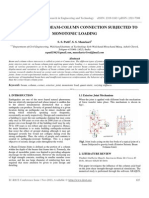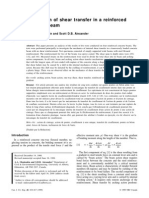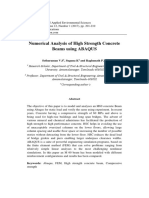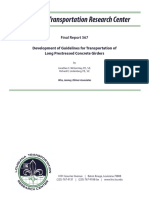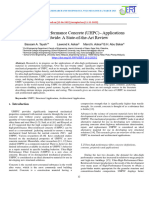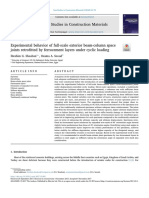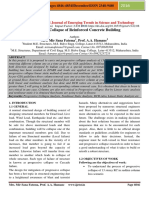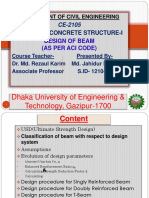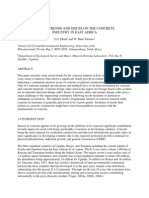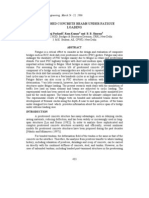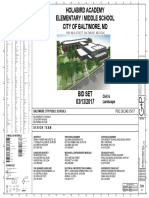Behaviour of Beam-Column Joint Under Cyclic Loading
Behaviour of Beam-Column Joint Under Cyclic Loading
Copyright:
Available Formats
Behaviour of Beam-Column Joint Under Cyclic Loading
Behaviour of Beam-Column Joint Under Cyclic Loading
Original Description:
Original Title
Copyright
Available Formats
Share this document
Did you find this document useful?
Is this content inappropriate?
Copyright:
Available Formats
Behaviour of Beam-Column Joint Under Cyclic Loading
Behaviour of Beam-Column Joint Under Cyclic Loading
Copyright:
Available Formats
IJRET: International Journal of Research in Engineering and Technology eISSN: 2319-1163 | pISSN: 2321-7308
__________________________________________________________________________________________
Volume: 03 Special Issue: 03 | May-2014 | NCRIET-2014, Available @ http://www.ijret.org 749
BEHAVIOUR OF BEAM-COLUMN JOINT UNDER CYCLIC LOADING
P.K.Joshi
1
, Jyoti B. Chavan
2
1
Associate Professor, Department of Civil Engineering, P.V.P.I.T. Budhgaon, Maharashtra, India
2
P.G. student, Department of Civil Engineering, P.V.P.I.T. Budhgaon, Maharashtra, India
Abstract
Beam-column joints of a reinforced concrete structure need special attention due to their highly complex behavior under seismic
loads, which is marked by a combination of large shear forces, diagonal tension and high bond stresses in the reinforcement bars, all
brittle mode of failure. This paper presents an experimental behavior of beam-column joints under cyclic loading. Four numbers of
exterior beam-column joint specimens were cast and tested under cyclic loading. The specimens were designed for seismic load
according to IS 1893(Part-I):2002 and IS 13920:1993. The test specimens were evaluated in terms of load-displacement relation, and
cracking pattern.
Keywords: R.C.C.Beam-column joints
----------------------------------------------------------------------***------------------------------------------------------------------------
1. INTRODUCTION
In RC buildings, portion of columns that are common to
beams at their intersections are called beam-column joints.
Since their constituent materials have limited strengths, the
joints have limited force carrying capacity. When forces larger
than these are applied during earthquakes, joints are severely
damaged. Repairing damaged joints is difficult, and so
damage must be avoided. Thus, beam-column joints must be
designed to resist earthquake effects. Under earthquake
shaking, the beams adjoining a joint are subjected to moments
in the same (clockwise or anticlockwise) direction. Under
these moments, the top bars in the beam-column joint are
pulled in one direction and the bottom ones in opposite
direction. These forces are balanced by bond stress developed
between concrete and steel in the joint region. If the column is
not wide enough or if the strength of concrete in the joint is
low, there is insufficient grip of concrete on the steel bars. In
such circumstances the bar slips inside the joint region, and
beams lose their capacity to carry load. Further, under the
action of the above pull-push forces at top and bottom ends,
joints undergo geometric distortion; one diagonal length of the
joint elongates and the other compresses.
Problem of diagonal cracking and crushing of concrete in the
joint region can be controlled by two mean, namely providing
large column sizes and providing closely spaced closed loop
steel ties around column bars in the joint region. The ties hold
together the concrete in the joint and also resist shear force,
thereby reducing the cracking and crushing of concrete.
Providing closed loop ties in the joint requires some extra
efforts. Indian standard IS 13920:1993 recommends
continuing the transverse loops around the column bars
through the joint region. In practice, this is achieved by
preparing the cage of the reinforcement (both longitudinal bars
and stirrups) of all beams at a floor level to be prepared on top
of the beam formwork of that level and lowered into the cage.
However, this may not always be possible particularly when
the beams are long and the entire reinforcement cage becomes
heavy. This paper consists of the study of the parameters like
load carrying capacity and cracking pattern. As per
N.Vijayalakshmi [5]
2. EXPERIMENTAL INVESTIGATION
In this experimental study, loading was applied in forward and
reverse cyclic loading and the behavior of joint is studied up to
failure.
2.1 Details of Specimen
For testing model, the dimension of beam was 120 170 mm
and beam length of 450mm and that column size was 120
230 mm. Height of the column was 375mm. The Fig.1 shows
the shape of formwork and reinforcement details for test
specimen.
Fig 1: Formwork and Reinforcement for test specimen
IJRET: International Journal of Research in Engineering and Technology eISSN: 2319-1163 | pISSN: 2321-7308
__________________________________________________________________________________________
Volume: 03 Special Issue: 03 | May-2014 | NCRIET-2014, Available @ http://www.ijret.org 750
2.2 Reinforcement Details
The reinforcement details of the specimens are shown in fig.2.
Six numbers of 8mm diameter bars were used for main
reinforcement of column and 6mm diameter lateral tie 30mm
c/c to 60mm c/c spacing, two numbers of 8mm diameter bar
were used for top reinforcement and two numbers were used
for bottom reinforcement of the beam. Shear reinforcement
consist of 6mm diameter at 30mm c/c from the face of column
up to 300mm and for remaining 60mm c/c.
.
Fig 2: Ductile Detailing Of Beam Column Joint as Per Is
13920: 1993
2.3 Casting and Curing
The mould is arranged properly and placed over a smooth
surface. The sides of the mould exposed to concrete were oiled
well to prevent the side walls of the mould from absorbing
water from concrete and to facilitate easy removal of the
specimen. The reinforcement cages were placed in the moulds
and cover between cage and form provided was 20mm.
concrete mix designed for M30 (1:1:2.5) and water cement
ratio is 0.40. Cement mortar block pieces were used as cover
blocks. The concrete contents such as cement, sand, aggregate
and water were weighed accurately and mixed. The mixing
was done till uniform mix was obtained. The concrete was
placed into the mould immediately after mixing and well
compacted. Control cubes and cylinders were prepared for all
the mixes along with concreting. The test specimen were
remolded at the end of 24 hours of casting. They were marked
identifications. They are cured in water for 28 days. After 28
days of curing the specimen was dried and white washed.
Fig 3: Casting Stage of Beam-Column Joint
2.4 Test Setup and Instrumentation
An axial load of 100 KN was applied on the column screw
jack has been used for applying load on the beam. The applied
load was cyclic in nature and deflection is measured for every
3 KN of loads by using deflection gauges. A complete test
setup as shown in fig4
Fig 4: Test setup for cyclic loading
3. BEHAVIOR OF BEAM-COLUMN JOINTS
The experimental results of RC Beam-Column Joint under
cyclic loading have been enumerated. The parameter load
carrying capacity is studied.
3.1 Load Carrying Capacity
The first crack was witnessed during 2nd cycle at the load
level of 12 KN. As the load was increased; further cracks were
developed in other portions. The ultimate load carrying
capacity of the RC Beam-Column Joint was 17KN recorded at
4
th
cycle.
IJRET: International Journal of Research in Engineering and Technology eISSN: 2319-1163 | pISSN: 2321-7308
__________________________________________________________________________________________
Volume: 03 Special Issue: 03 | May-2014 | NCRIET-2014, Available @ http://www.ijret.org 751
3.2 Load Deflection Characteristics
The corner beam-column joint specimen was subjected to
cyclic loading simulating earthquake loads. The load was
applied by using screw jack. Totally 6 cycles were imposed.
The beam-column joint was gradually loaded by the load level
during each cycle. As the load level was increased in each
cycle, the observed deflection was greater than it was in earlier
cycle.
Fig 5: Load Vs Displacement Curve Subjected to Cyclic
Loading
3.3 Mode of Failure
The corner beam-column joint test specimen was tested under
cyclic loading. During the forward loading cracks have been
developed at the top of the specimen As the loading was
progressed the width of crack has been widened. And the
reverse of the load specimen has to be in the reverse positions,
cracks have been formed at the bottom tension and the cracks
already formed in the tension face have to be closed. This
opening and closing of the cracks has been confirmed till the
final failure of the specimen takes place. The complete failure
pattern of the Beam-Column joint is shown in fig.6.
Fig 6: Failure at Ultimate Load
4. CONCLUSIONS
As the load level was increased in each cycle, the observed
deflection was greater than it was in earlier cycle.
During the forward loading cracks have been developed at the
top of the specimen As the loading was progressed the width
of crack has been widened. And the reversal of load specimen
has to be in the reversed positions, cracks have been formed at
the bottom tension and the cracks already formed in the
tension face have to be closed.
REFERENCES
[1]. Antonopoulos C.P. and Triantafillou T. C., (2002)
Analysis of FRP-Strengthened RC Beam-Column Joints,
Journal of Composites for Construction-Volume 6, Issue 1, pp.
41-51
[2]. Calvi, GM, Magenes, G, Pampanin, S, (2002),
Experimental Test on a Three Storey Reinforced Concrete
Frame Designed for Gravity Only, 12th European Conference
on Earthquake Engineering, paper n.727
[3]. G.A.Lakshmi, Anjan Dutta and S.K.Deb, (2008)
Numerical studies of strengthening of beam column joint
under cyclic excitation using FRP composites Journals of
structural Engineering, Vol 35,No 1, pp 59-65.
[4]. Gopal Rai, (2010) Fiber Reinforced Polymer
Composites, A novel way for strengthening structures, ICI-
Asian Conference on Ecstacy of Concrete
[5]. N.Vijayalakshmi, M.Kalaivani, A.Murugesan,
G.S.Thirugnanam, (2010) Experimental Investigation of RC
Beam Column Joint Strengthening by FRP Wrapping civil
and structural engineering Volume 1, No 1,
[6]. Tsonos, A. G., (2001) Seismic Retrofit of R/C Beam-to-
Column Joints using Local Three-Sided Jackets, European
Earthquake Engineering, No. 1, pp. 48-64.
[7]. IS 13920-1993 Earthquake Engg. Code Clause no. 6, 7,
8.1 & 8.2
You might also like
- Case Study Structure Building Collapse - CompressDocument9 pagesCase Study Structure Building Collapse - CompressnaserNo ratings yet
- Nato Foreign Diesel Comparative Test Program Gm-Mvo Mt883 Engine EvaluationDocument101 pagesNato Foreign Diesel Comparative Test Program Gm-Mvo Mt883 Engine EvaluationStefan DjordjevskiNo ratings yet
- Infographic - 9800 Know Boards by Name V1.3Document1 pageInfographic - 9800 Know Boards by Name V1.3Sterian VladNo ratings yet
- Comparative Study On Behaviour of Reinforced Beam-Column Joints With Reference To Anchorage DetailingDocument6 pagesComparative Study On Behaviour of Reinforced Beam-Column Joints With Reference To Anchorage DetailingMohd parvezNo ratings yet
- A Study of R.C.C. Beam-Column Connection Subjected To PDFDocument7 pagesA Study of R.C.C. Beam-Column Connection Subjected To PDFInternational Journal of Research in Engineering and TechnologyNo ratings yet
- Mechanism of Shear TransferDocument8 pagesMechanism of Shear TransferSana'a AamirNo ratings yet
- Design and Seismic Behaviour of Taller Eccentrically Braced Frames PDFDocument14 pagesDesign and Seismic Behaviour of Taller Eccentrically Braced Frames PDFsuitamNo ratings yet
- PrefabrikatyDocument25 pagesPrefabrikatyJoeNo ratings yet
- Experimental Study of Concrete Filled Tubular Short ColumnsDocument7 pagesExperimental Study of Concrete Filled Tubular Short ColumnsAnonymous kw8Yrp0R5r100% (1)
- Chien1993 PDFDocument33 pagesChien1993 PDFRicardo MoraisNo ratings yet
- Abaqus - Nonlinear Analysis of Reinforced Concrete Beam Experimentation2015Document5 pagesAbaqus - Nonlinear Analysis of Reinforced Concrete Beam Experimentation2015oioNo ratings yet
- CE470 Preface (06sept2012) - PDF PDFDocument6 pagesCE470 Preface (06sept2012) - PDF PDFNos GoteNo ratings yet
- Sunder CFT Column ReportDocument33 pagesSunder CFT Column Reportsunder kumawatNo ratings yet
- Numerical Analysis of High Strength Concrete Beams Using ABAQUSDocument10 pagesNumerical Analysis of High Strength Concrete Beams Using ABAQUSJangdiniNo ratings yet
- A Critical Analysis of Arthur Ravenel Jr. Bridge New Cooper River BridgeDocument7 pagesA Critical Analysis of Arthur Ravenel Jr. Bridge New Cooper River BridgeHoàng LongNo ratings yet
- FR - 567 Development of Guidelines For Transportation of Long Prestressed Concrete GirdersDocument294 pagesFR - 567 Development of Guidelines For Transportation of Long Prestressed Concrete GirderswalaywanNo ratings yet
- Ultra-High-Performance Concrete (UHPC) - ApplicationsDocument17 pagesUltra-High-Performance Concrete (UHPC) - Applicationsjuan danielNo ratings yet
- Experimental Behavior of Full-Scale Exterior Beam-Column Space Joints Retrofitted by Ferrocement Layers Under Cyclic LoadingDocument18 pagesExperimental Behavior of Full-Scale Exterior Beam-Column Space Joints Retrofitted by Ferrocement Layers Under Cyclic LoadingPrakumarNo ratings yet
- PrestressManual Rev1Document77 pagesPrestressManual Rev1cordobaluisfNo ratings yet
- DCR Ratio Method For Progressive Failure of A StructureDocument9 pagesDCR Ratio Method For Progressive Failure of A StructureOnee Yetoo AseemeNo ratings yet
- Concept of STM Paper ACIDocument9 pagesConcept of STM Paper ACIshish0iitrNo ratings yet
- Interrelation of Structural Stability, Stiffness, Residual Stress and Natural FrequencyDocument14 pagesInterrelation of Structural Stability, Stiffness, Residual Stress and Natural FrequencyHarshada DhekaleNo ratings yet
- Design of ACI-type Punching Shear Reinforcement To Eurocode 2Document15 pagesDesign of ACI-type Punching Shear Reinforcement To Eurocode 2ephremNo ratings yet
- Nonlinear Analysis of RC Beams Based On Moment-Curvature RelationDocument14 pagesNonlinear Analysis of RC Beams Based On Moment-Curvature RelationSamia ChowdhuryNo ratings yet
- Evaluation of Ultra-High-Performance-Fiber Reinforced Concrete Binder Content Using The Response Surface MethodDocument9 pagesEvaluation of Ultra-High-Performance-Fiber Reinforced Concrete Binder Content Using The Response Surface MethodNuril IshakNo ratings yet
- 201 Behaviour of Reinforced Concrete Interior Beam Column Joints CompressedDocument137 pages201 Behaviour of Reinforced Concrete Interior Beam Column Joints CompressedAtano RoyNo ratings yet
- Architect Micheal HopkinsDocument44 pagesArchitect Micheal HopkinsEddie MachariaNo ratings yet
- Construction and Building Materials: P.P. Li, H.J.H. Brouwers, W. Chen, Qingliang YuDocument11 pagesConstruction and Building Materials: P.P. Li, H.J.H. Brouwers, W. Chen, Qingliang YuKashif NaukhezNo ratings yet
- A Critical Analysis of Castleford Footbridge, England: P. D. WilsonDocument10 pagesA Critical Analysis of Castleford Footbridge, England: P. D. WilsonAshdeep SinghNo ratings yet
- Seismic Performance and Design of Bolted Steel Moment Resisting Frames PDFDocument16 pagesSeismic Performance and Design of Bolted Steel Moment Resisting Frames PDFJOHNY HUMBERTO PONTON CORREANo ratings yet
- Pre Stressing & Post Tension IngDocument8 pagesPre Stressing & Post Tension IngRavi PrakashNo ratings yet
- 03 - Hilti Shear Connectors X-HVBDocument8 pages03 - Hilti Shear Connectors X-HVBing urban100% (1)
- Properties of A Semi-Discrete Approximation To The Beam EquationDocument11 pagesProperties of A Semi-Discrete Approximation To The Beam EquationjtorerocNo ratings yet
- Comparison Between Experimental and Numerical Studies of Fully Encased Composite ColumnsDocument8 pagesComparison Between Experimental and Numerical Studies of Fully Encased Composite ColumnsAbdul BariNo ratings yet
- Plate Girder Intro2013 PDFDocument15 pagesPlate Girder Intro2013 PDFTapu mojumder100% (1)
- Kuchma Et Al-1998-Progress in Structural Engineering and MaterialsDocument10 pagesKuchma Et Al-1998-Progress in Structural Engineering and MaterialsxforceNo ratings yet
- Submitted By: Under The Guidance: Dr. K. AshaDocument23 pagesSubmitted By: Under The Guidance: Dr. K. AshaMohammed AhmedNo ratings yet
- Jennifer Dietrich MSC DissertationAnalysis and Design of PDFDocument238 pagesJennifer Dietrich MSC DissertationAnalysis and Design of PDFopulitheNo ratings yet
- Gravity Load Collapse of Reinforced Concrete Frames: Kenneth J. ElwoodDocument77 pagesGravity Load Collapse of Reinforced Concrete Frames: Kenneth J. ElwoodRachid BENTAFATNo ratings yet
- Designofbeamslideshare PDFDocument26 pagesDesignofbeamslideshare PDFVRKVRK10No ratings yet
- Interview Questions: 1. What Is Creep of A Concrete? and It's Effects of StructureDocument27 pagesInterview Questions: 1. What Is Creep of A Concrete? and It's Effects of StructureRupesh KhandekarNo ratings yet
- Boundary Singularities in Linear Elliptic Differential EquationsDocument11 pagesBoundary Singularities in Linear Elliptic Differential EquationsjtorerocNo ratings yet
- v04 Savor Croartian Bridges SofistikDocument39 pagesv04 Savor Croartian Bridges SofistikVenkatesha HebbarNo ratings yet
- CIRIA P3198 Piling Guides v2Document2 pagesCIRIA P3198 Piling Guides v2ananda ganeshNo ratings yet
- Cobiax Folder Big5 EDocument2 pagesCobiax Folder Big5 Emadamarin_21No ratings yet
- From CP 114 To BS8110 EssayDocument10 pagesFrom CP 114 To BS8110 EssayAlan CheungNo ratings yet
- Compressive Stress Strain Relationship of Steel Fibre-Reinforced Concrete at Early AgeDocument14 pagesCompressive Stress Strain Relationship of Steel Fibre-Reinforced Concrete at Early AgesonugaurNo ratings yet
- Partially Prestressed Concrete Structures - A Design Challenge PDFDocument32 pagesPartially Prestressed Concrete Structures - A Design Challenge PDFCharlene CardinozaNo ratings yet
- Behavior of Braced FramesDocument12 pagesBehavior of Braced FramesJaime MercadoNo ratings yet
- ACI PRC-364.8-22: Hydrodemolition For Concrete Removal in Unbonded Post-Tensioned Svstems,-TechnoteDocument3 pagesACI PRC-364.8-22: Hydrodemolition For Concrete Removal in Unbonded Post-Tensioned Svstems,-TechnoteMoGHNo ratings yet
- Miami Pedestrian Bridge Collapse Computational Forensic AnalysisDocument17 pagesMiami Pedestrian Bridge Collapse Computational Forensic AnalysisAmmar100% (1)
- 4 Pierre-YvesSousesme PDFDocument21 pages4 Pierre-YvesSousesme PDFAhmed BesoNo ratings yet
- Web 5133Document118 pagesWeb 5133bbblguNo ratings yet
- Slim Concrete Columns EC Vs BS - NHBCDocument25 pagesSlim Concrete Columns EC Vs BS - NHBCalberto5791No ratings yet
- Determining Concrete Strength Using Small-Diameter Cores: J. H. BungeyDocument8 pagesDetermining Concrete Strength Using Small-Diameter Cores: J. H. BungeyWiryanto DewobrotoNo ratings yet
- Advanced Opensees Algorithms, Volume 1: Probability Analysis Of High Pier Cable-Stayed Bridge Under Multiple-Support Excitations, And LiquefactionFrom EverandAdvanced Opensees Algorithms, Volume 1: Probability Analysis Of High Pier Cable-Stayed Bridge Under Multiple-Support Excitations, And LiquefactionNo ratings yet
- Structural Engineering DocumentsFrom EverandStructural Engineering DocumentsJorge de BritoNo ratings yet
- Cyclic Behaviour of Beam Column Joint Retrofitted With Simcon LaminatesDocument20 pagesCyclic Behaviour of Beam Column Joint Retrofitted With Simcon LaminatesJay PatelNo ratings yet
- Art 12Document11 pagesArt 12rammirisNo ratings yet
- Wcee2012 4133Document10 pagesWcee2012 4133toyi kamiNo ratings yet
- Torsional Strengthening of Reinforced Concrete Box Beams Using Carbon Fiber Reinforced PolymerDocument7 pagesTorsional Strengthening of Reinforced Concrete Box Beams Using Carbon Fiber Reinforced Polymernvel0006No ratings yet
- TK10 Quick Use InstructionDocument3 pagesTK10 Quick Use Instructiontekno dwatchNo ratings yet
- 13 HorticultureDocument1 page13 Horticulturenitin guptaNo ratings yet
- BBC Cellpack - IntroDocument13 pagesBBC Cellpack - IntroSelva MuthukumarNo ratings yet
- Application Uninstalling MSDocument2 pagesApplication Uninstalling MSRama Tenis CopecNo ratings yet
- Sir Ica Secc Ref Rev0Document1 pageSir Ica Secc Ref Rev0victorlizcanoNo ratings yet
- Aircraft Electrical Load and Power Source Capacity Analysis: Standard Guide ForDocument8 pagesAircraft Electrical Load and Power Source Capacity Analysis: Standard Guide Forjuli_navia3482100% (4)
- Civil Landscape Holabird Bid Set DrawingsDocument53 pagesCivil Landscape Holabird Bid Set DrawingskarthikNo ratings yet
- MicrometerDocument21 pagesMicrometerSiswantoeNo ratings yet
- 580 Church - HeritageDocument10 pages580 Church - HeritageAshleigh GaulNo ratings yet
- PP Aaa PP1 133Document24 pagesPP Aaa PP1 133Rabah AmidiNo ratings yet
- Liquid Liquid ExtractionDocument36 pagesLiquid Liquid ExtractionChezka AmparoNo ratings yet
- StopWatch App Source CodeDocument8 pagesStopWatch App Source CodeSasiNo ratings yet
- Airport Information: Details For Husein SastranegaraDocument8 pagesAirport Information: Details For Husein SastranegaraOzhen SelexboysNo ratings yet
- Segregation TableDocument1 pageSegregation TableLjupce GorgievskiNo ratings yet
- Cell Selection & ReslectionDocument9 pagesCell Selection & ReslectionVishalNo ratings yet
- Schedule of Loads (Pb2) : JS ELDocument1 pageSchedule of Loads (Pb2) : JS ELStephany PolinarNo ratings yet
- Data Structures NotesDocument9 pagesData Structures NotesMohammed JeelanNo ratings yet
- BV Options DetailsDocument4 pagesBV Options DetailslorenzoNo ratings yet
- Refrigerador MK-204Document88 pagesRefrigerador MK-204DORIS TORRESNo ratings yet
- UT Testing-Study NotesDocument1,224 pagesUT Testing-Study NotesCharlie Chong94% (18)
- Eurovac High Volume Collector PackageDocument15 pagesEurovac High Volume Collector PackageDaniel AustinNo ratings yet
- News CRT Sep06 LiftDocument3 pagesNews CRT Sep06 Liftkla_alkNo ratings yet
- MXCXKX K M C M A Xa V X V X X A X V X FT F T: Mechanical Vibrations Free Vibration of Single-Degree-of-Freedom SystemsDocument2 pagesMXCXKX K M C M A Xa V X V X X A X V X FT F T: Mechanical Vibrations Free Vibration of Single-Degree-of-Freedom Systemsmaleka anjumNo ratings yet
- Fireproofing Services BrochureDocument2 pagesFireproofing Services BrochurePiyush JainNo ratings yet
- Modular Procedural AutomationDocument24 pagesModular Procedural Automationsahil4INDNo ratings yet
- Schedule of SlabsDocument1 pageSchedule of SlabsJericho Jon IlocoNo ratings yet
- Premium Performance Makes A Difference: Voestalpine Precision Strip GMBHDocument36 pagesPremium Performance Makes A Difference: Voestalpine Precision Strip GMBHRicardo PirelaNo ratings yet
- VoskhodDocument11 pagesVoskhodjackie_fisher_email8329100% (1)




